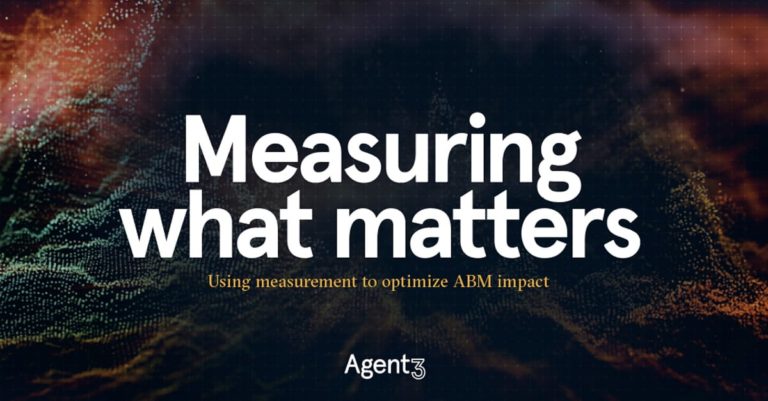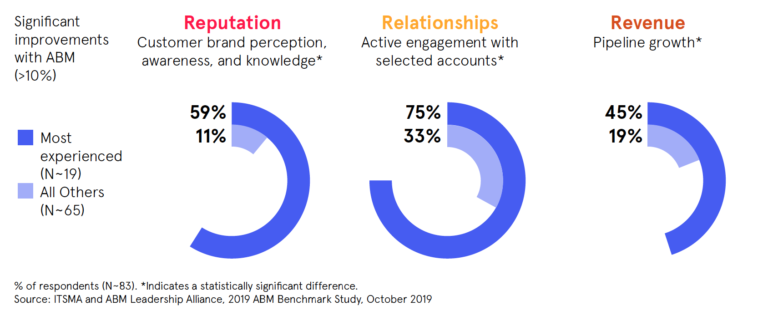ABM works: here’s how to prove it.
So we know ABM works, but we also know from previous posts in this series, that proving this fact, is challenging. We don’t claim to have all the answers and there’s no hard and fast rule for every program, but in this, the third of our 3-part blog series about measurement, we will look at some practical steps practitioners can take to help show value from their ABM investment.
So firstly, why IS measurement so hard?
As we saw in the first of these blog posts there are multiple challenges to effective measurement of ABM programs, but they all broadly fall into three main categories:
- Organizational alignment: Agreeing on what to measure
- Data and analytics: Collecting and analyzing the right data to improve performance and demonstrate impact
- Systems and tools: Building and evolving the right systems to enable continuous improvement and effective communication

So what’s the answer?
Not all desired outcomes are immediately linked to revenue, so the ITSMA ‘Three R’ framework for ABM is a useful framework to use for best practice measurement. Looking at outcomes around reputation, relationships and revenue means that, behind each of these pillars, you can align metrics that can lead to the strategic growth drivers of any business (all of which need to be measured).
Reputation
- Drives preference with named accounts
- Builds reputation in new markets
- Improves internal credibility
Relationships
- Identifies and engages with key stakeholders
- Deepens relationships for insight and innovation
- Develops references, referrals and advocates
Revenue
- Grows and accelerates pipeline
- Sells new offerings and enters new markets
- Increases win rate and deal size
And you can start seeing results straight away if you set short, medium and long term metrics as demonstrated here:

How to measure using the “three R’s”
There is no one-size-fits-all approach to applying the “three R’s” to your measurement. Each organization is different with an ABM strategy and approach that aligns to their specific business goals. As a starting point, it’s worth considering these points when reviewing your current process and structure for measurement:
- Your measurement must be pinned back to your business strategy
- Consider how you would take existing measures for your ABM program and reprioritize and reorganize them based on an appropriate timeframe that meets your ABM roadmap
- Existing KPIs you may currently use might not be appropriate in your new approach to measurement
- Identify any gaps in processes, data and metrics which prevent you from achieving a robust measurement framework
Do you have the right tools?
You might be asking whether you have the right tools in place to do all of this and get the data you need. or even what types of data you need to capture.
There is more on the different types of data in the guide but, to begin with, it is worth assessing if you can get the insight and data you need from existing systems, rather than investing in new systems and tools. Is everyone using Salesforce to the best of their abilities? Do people need more training? Or a package upgrade?
Building attribution and measurement into an ABM framework from the start is crucial but understandably challenging. While technology will go some way to easing this pain, ITSMA research reveals that 61% of companies expect to use AI for account insight and 43% for measuring ABM and attribution – for the moment at least, there is still some manual work to do and you need to be set up to do it.
How do you optimize your ABM strategy through measurement?
This goes back to the ITSMA’s ABM Adoption Model that maps the seven dimensions that support the adoption of ABM across the business. Do you know where your organization sits?
Knowing which of the four stages of adoption you’re in is important in ensuring your measurement framework reflects the necessary expected outcomes of that stage – this will allow you to continue optimizing your strategy. In addition, a hard-working dashboard, aligned to the ABM Adoption Model, will give you the data you need to demonstrate results to the wider business and show that ABM works.
Time and time again with clients, we see that a framework that measures outcome-based metrics that align to the “three R’s” is proven to demonstrate the value of ABM to the rest of the business, scale ABM easier and show progress against the key business goals set out. (Not to mention demonstrate your own value as an ABM-er).
But it takes commitment to overcome any challenges in data sources, systems, tools and alignment which prevent seamless integration and information sharing that is vital in measurement. Measurement is a journey, and as the band Journey famously said “Don’t stop believin’” – your path to measurement excellence is in reach!
The full guide to measurement is available to download here. You can also replay our ABM measurement webinar by registering here. If you want to have a chat about measurement in greater detail, or to find out more about Agent3’s partnership with the ITSMA, please do get in touch. We’d love to hear from you!
